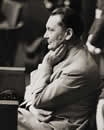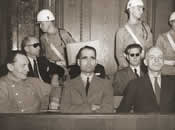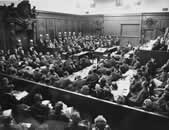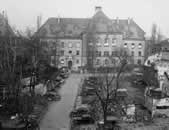Sixty-five years ago, the world revolved around Nuremberg, Germany, where the Third Reich’s highest officials faced trial for Nazi atrocities.
By Mark Weisenmiller
British Prime Minister Winston Churchill wanted blood. As the demise of Nazi Germany drew near, the Allied powers could not decide what to do with captured Nazi leaders. Churchill offered a simple solution: kill them.
US Secretary of War Henry L. Stimson had a less drastic proposal. He believed the top Nazis should be charged in a special international court. He argued to President Franklin Roosevelt that executing Nazi prisoners would be vengeance, not justice. What won Roosevelt over was Stimson’s conviction that a war-crimes tribunal could conceivably declare war illegal.
 Plans for what to do with the Nazis and Germany after the war had begun to turn up as soon as the end became imminent. In the summer of 1944, US Treasury Secretary Henry Morgenthau, Jr., came up with a plan to transform Germany’s economy from industrial to agricultural and completely de-Nazify the country. The plan included deporting some Nazis and forcing others into labor. Both Churchill and Roosevelt approved the Morgenthau Plan when they met at the Quebec Conference in September 1944. It was the Soviet Union that would first suggest publicly that the top Nazis be put on trial.
Plans for what to do with the Nazis and Germany after the war had begun to turn up as soon as the end became imminent. In the summer of 1944, US Treasury Secretary Henry Morgenthau, Jr., came up with a plan to transform Germany’s economy from industrial to agricultural and completely de-Nazify the country. The plan included deporting some Nazis and forcing others into labor. Both Churchill and Roosevelt approved the Morgenthau Plan when they met at the Quebec Conference in September 1944. It was the Soviet Union that would first suggest publicly that the top Nazis be put on trial.
Eventually the Allies agreed to an international war-crimes trial for the Nazis, but work on putting together the legal framework was delayed when Roosevelt died on April 12, 1945. His successor, Harry Truman, appointed US Supreme Court Associate Justice Robert H. Jackson to represent America on the international committee that was setting up the trials. Together with emissaries from France, Great Britain, and the Soviet Union, Jackson and a team of lawyers created the draft of what would be become known as the London Agreement. It was signed into effect on August 8, 1945.
 Much of the legal standing for the International Military Tribunal that the London Agreement created to put the Nazis on trial came from a report by US Army Colonel Murray Bernays entitled “Trial of European War Criminals.” Bernays was a 51-year-old, New York–born, Lithuanian-Jewish attorney who was chief of the US War Department’s Special Projects Branch. He came up with the four charges that would be leveled against the Nazi defendants: crimes against peace (mainly waging wars of aggression and waging war in violation of international treaties), conspiracy of participation or the accomplishment of charge one, war crimes (with an emphasis on the mistreatment of prisoners of war), and crimes against humanity (including “murder, extermination, enslavement, deportation and other inhumane acts committed against any civilian population, before or during the war, or persecutions on political, racial, or religious grounds…”).
Much of the legal standing for the International Military Tribunal that the London Agreement created to put the Nazis on trial came from a report by US Army Colonel Murray Bernays entitled “Trial of European War Criminals.” Bernays was a 51-year-old, New York–born, Lithuanian-Jewish attorney who was chief of the US War Department’s Special Projects Branch. He came up with the four charges that would be leveled against the Nazi defendants: crimes against peace (mainly waging wars of aggression and waging war in violation of international treaties), conspiracy of participation or the accomplishment of charge one, war crimes (with an emphasis on the mistreatment of prisoners of war), and crimes against humanity (including “murder, extermination, enslavement, deportation and other inhumane acts committed against any civilian population, before or during the war, or persecutions on political, racial, or religious grounds…”).
Jurists and critics found a number of legal and philosophical problems with the trials. Among them were that the defendants could not use a tu quoque (you did it too) defense; that the trials followed the Anglo-American adversarial procedure rather than the European inquisitorial system (where the judge has a prosecutorial role), even though the trials were to be held in Germany; that the defendants had no say in the selection of the eight presiding judges (two each from the United States, Great Britain, France, and the Soviet Union); that the defendants could not appeal their verdicts; and that the London Agreement was based only minimally on actual international law.
Jackson—who quickly emerged as the leader of the team of 46 prosecutors representing the four major Allied powers—and his legal colleagues had some responses for the critics. They let the defendants choose their own attorneys, provided those attorneys with fully paid legal help if they wanted it, and supplied simultaneous-translation earphones for all the defendants and their attorneys in the courtroom.
 The major justification for the trials was the Holocaust, and the ability to make a strong case was rooted in the nearly 500 tons of Nazi documents the Allies had confiscated. Those documents chronicled in intricate detail the history of the Nazis and their planning and carrying out of the Holocaust. Various Nazi-affiliated organizations had killed Jews and others whom they considered undesirable almost from the moment the Nazis took control of Germany in 1933. But it was a January 20, 1942, meeting of 15 Nazi officials, known as the Wannsee Conference, that began the systematic killing of Jews and others in Nazi-occupied countries. The three major advocates of the Nazis’ so-called Final Solution—Adolf Hitler, Minister of the Interior Heinrich Himmler, and Deputy Chief of the Gestapo (Secret State Police) Reinhard Heydrich—were dead, but the world’s horror at the Holocaust demanded retaliation.
The major justification for the trials was the Holocaust, and the ability to make a strong case was rooted in the nearly 500 tons of Nazi documents the Allies had confiscated. Those documents chronicled in intricate detail the history of the Nazis and their planning and carrying out of the Holocaust. Various Nazi-affiliated organizations had killed Jews and others whom they considered undesirable almost from the moment the Nazis took control of Germany in 1933. But it was a January 20, 1942, meeting of 15 Nazi officials, known as the Wannsee Conference, that began the systematic killing of Jews and others in Nazi-occupied countries. The three major advocates of the Nazis’ so-called Final Solution—Adolf Hitler, Minister of the Interior Heinrich Himmler, and Deputy Chief of the Gestapo (Secret State Police) Reinhard Heydrich—were dead, but the world’s horror at the Holocaust demanded retaliation.
Soviet officials wanted the trials to take place in Berlin, the capital of Germany, but the other Allies favored the walled city of Nuremberg (Nürnberg in German). It would be a symbolic setting. From 1933 to 1938, the Nazis had held their annual party gathering there. In September 1935, Hitler signed into existence the Nuremberg Laws, which stripped German Jews of all civil rights, took away most legal rights of Germans of part-Jewish descent, and forbade marriage and sexual relations between Jews and non-Jews.
There were practical reasons for choosing Nuremberg, too. In 1945, Germany was divided into four sectors, and Nuremberg was in the American one, where the headquarters of lead prosecutor Jackson was located. Nuremberg’s Palace of Justice and its accompanying prison had mostly escaped damage by Allied bombing, and both were able to be modified for the needs of the trial and the jailors.
The indictments were delivered on Friday, October 19, 1945, and the International Military Tribunal began the first of the series of Nazi trials in Nuremberg on November 20, 1945. The list of defendants was a who’s who of Nazi brass, including Reich Marshal Hermann Göring, Deputy Führer Rudolf Hess, Reich Bank president Walther Funk, and Chief of Operations of Armed Forces Alfred Jodl.
A galaxy of journalism stars assembled to shed light on the historic proceedings for the public around the globe. The gathering of English-speaking reporters included Walter Cronkite for the United Press, Howard K. Smith and William L. Shirer for CBS radio, Marguerite Higgins and Drew Middleton for the New York Herald Tribune, Drew Middleton for the New York Times, Janet Flanner and Rebecca West for the New Yorker, Wes Gallagher for the Associated Press, and novelist John Dos Passos for Life.
Presiding judge Sir Geoffrey Lawrence of Great Britain ran the day-to-day proceedings. “Sir Geoffrey’s father was a Lord Chief Justice, and he brings to legal procedure the quality that the second generation of a theatrical family brings to Shakespeare,” wrote the New Yorker’s West. “He has the most charming voice in the world, and a silvery querulousness that can flay without drawing a single drop of Blood.”
At exactly 10 a.m. on November 20, Lawrence rapped his oak gavel (which was stolen soon afterward, leaving him to tap a pen or pencil repeatedly whenever he needed to restore order in the courtroom for the rest of the trial). “This trial, which is now to begin, is unique in the annals of jurisprudence of the world, and it is of supreme importance to millions of people all over the globe,” he announced. The rest of the first day was spent on the reading of the indictments.
On the morning of day two, the defendants entered their pleas. First to be called was Göring, who started into a speech he had written for the occasion, but was quickly cut off by Lawrence. Angry, Göring cut to the chase, “I declare myself, in the sense of the indictment, not guilty.” Next was Hess, who yelled “Nein!” (“No!”). Laughter came from the gallery when Lawrence said “That will be entered as a plea of not guilty.” He was not amused and warned the court. By lunch time, all the defendants had pleaded not guilty.
That afternoon, Jackson began the trial for the prosecution with a moving speech. “The privilege of opening the first trial in history for crimes against the peace of the world imposes a grave responsibility,” he said. “The wrongs which we seek to condemn and punish have been so calculated, so malignant, and so devastating, that civilization cannot tolerate their being ignored because it cannot survive their being repeated.” He went on for five hours.
 Sir Hartley Shawcross, Great Britain’s main prosecutor, also made memorable opening remarks. He took a few minutes to read from an affidavit submitted by Herman Graebe, a German construction worker who did some work in the town of Dubno in the Ukraine. Shawcross offered Graebe’s account of the fate of numerous Jews in the area: “Without screaming or weeping, these people undressed, stood around in family groups, kissed each other, said farewells…. A father was holding the hand of a boy about ten years old and speaking to him softly; the boy was fighting his tears….” Shawcross went on to tell the court that a German SS unit assigned to Dubno shot to death 5,000 Jews in one afternoon and buried their bodies in a pit. The recounting brought the first audible gasps and cries from the courtroom. There would be many more in the months to come.
Sir Hartley Shawcross, Great Britain’s main prosecutor, also made memorable opening remarks. He took a few minutes to read from an affidavit submitted by Herman Graebe, a German construction worker who did some work in the town of Dubno in the Ukraine. Shawcross offered Graebe’s account of the fate of numerous Jews in the area: “Without screaming or weeping, these people undressed, stood around in family groups, kissed each other, said farewells…. A father was holding the hand of a boy about ten years old and speaking to him softly; the boy was fighting his tears….” Shawcross went on to tell the court that a German SS unit assigned to Dubno shot to death 5,000 Jews in one afternoon and buried their bodies in a pit. The recounting brought the first audible gasps and cries from the courtroom. There would be many more in the months to come.
Jackson convinced the Allied prosecution team that introducing the confiscated Nazi documents as evidence would make a strong foundation for their case. He was probably right, but he failed to realize that while the strategy was legally sound, it was incredibly boring. The prosecution needed an emotional plea.
That emotional plea came in the form of a black-and-white film from Hollywood director George Stevens. Stevens had been a lieutenant colonel in the army and was in charge of a film crew unit during the war. When the Allies began to discover the Nazi concentration and death camps in Europe in the spring of 1944, Supreme Allied Commander General Dwight D. Eisenhower ordered Stevens and his crew to make a movie of what the Allied troops were finding.
 The prosecution showed the film on November 29, 1945, which quickly became the most memorable day of the trial. Titled Nazi Concentration Camps, the movie showed massive piles of bodies at Belsen, Mauthausen, and other camps. There were emaciated survivors, some barely alive. People cried in the darkened courtroom, and several had to be helped out. After the screening ended, a film made by Germans that showed SS soldiers killing people in various manners was shown. When that one ended, the courtroom lights were turned back on, revealing that Lawrence had lost control of his emotions—for the first and only time during the trials. Without comment, he got up and practically ran out of the courtroom. He didn’t return for the day.
The prosecution showed the film on November 29, 1945, which quickly became the most memorable day of the trial. Titled Nazi Concentration Camps, the movie showed massive piles of bodies at Belsen, Mauthausen, and other camps. There were emaciated survivors, some barely alive. People cried in the darkened courtroom, and several had to be helped out. After the screening ended, a film made by Germans that showed SS soldiers killing people in various manners was shown. When that one ended, the courtroom lights were turned back on, revealing that Lawrence had lost control of his emotions—for the first and only time during the trials. Without comment, he got up and practically ran out of the courtroom. He didn’t return for the day.
Göring became the media star of the trials, and reporters looked forward to the face-off between him Jackson. They were disappointed when Göring finally took the stand on March 18, 1946. Jackson, who hadn’t prosecuted a case in years and technically was not even a lawyer (he earned a certificate of completion from the Albany Law School in New York, but not a law degree), could not control Göring’s long answers to his questions and appealed to Lawrence for help. Lawrence replied, “Mr. Jackson, the tribunal thinks the witness ought to be allowed to make what explanation he thinks right in answer to this question.” From that moment on, Jackson was at a loss for what to do. Whenever he tried to press Göring, the former Reich marshal would go off on another long, convoluted answer. At one point Jackson was so frustrated that he threw down his simultaneous-translation earphones in disgust.
Great Britain’s prosecutors came to the rescue. The brilliant Scottish attorney Sir David Maxwell-Fyfe questioned Göring next. Göring didn’t stand a chance against him. He asked Göring about his connection to the deliberate execution of British Royal Air Force pilots who had escaped from a German prison camp in Sagan, Poland. “You are saying that you knew nothing about it and are now trying to shift the responsibility onto the shoulders of your junior officers?” he asked.
“That is untrue,” Göring responded. “I consider this matter the worst business of the whole war. I never contradicted Hitler so strongly or sharply as I did over the RAF flyers.”
“Well that may be your view,” Maxwell-Fyfe said, “but I am suggesting that when every one of these officers of yours knew about it, you knew about it too, and that you did nothing to prevent these men from being shot. You cooperated in this foul series of murders.”
Denying everything, Göring eventually cried out, “Why do you keep asking me about these annihilation camps?!?”
Maxwell-Fyfe shot back, “[Wilhelm] Hoettl [a top SS officer] says approximately four million Jews have been killed…. Assume those figures are only 50 percent correct. Are you telling this tribunal that a minister with your power in the Reich could remain ignorant of what was going on?”
“That is what I am stating…,” Göring answered. “These things were kept secret from me. I am even of the opinion the Führer did not know approximately what was going on.”
When the questioning of Göring finally ended, he had been on the witness stand for almost 10 days. No other defendant sat there so long.
The witness who gave probably the tensest testimony was Madame Vaillant Couturier, a stunningly beautiful French woman who was at the Auschwitz death camp and then transferred to the Ravensbruck concentration camp. She told the court of medical experiments performed on women at Ravensbruck. “When they [camp guards] wanted to take others away from operations they [female prisoners] refused to enter the hospital,” she testified. “They were then taken by force to special cells, and there operated on by a professor in uniform who came from Berlin, and who never took the slightest antiseptic precautions.…” After she finished testifying, Couturier passed Göring in the dock, and it appeared that she was about to attack him physically. A white- helmeted American guard stepped between the two.
After 73 days, the prosecution rested, and the defense took its turn. Its case began on March 4, 1946, and lasted until August 31. Hans Fritzsche, former commander in chief of the Reich’s army, was the last defendant to make a public statement. Ninety-four witnesses had spoken, and more than 4,000 documents had been entered into evidence.
The judges deliberated for a full month before delivering their verdict on October 1, 1946. Eleven of the defendants, including Göring, were found guilty of all four charges. All of them heard the words “Tode durch den strang!” (“Death by the rope!”) through their earphones. Three received life in prison. Four received prison sentences of various lengths. Three were acquitted. (See the charging and sentencing details.)
In prison, Göring received a visit from his wife, Emmy. He told her “They will not hang me.” He was right. Hours before his scheduled execution in October 1946, he popped a tiny hidden glass capsule of cyanide into his mouth, bit down hard on it, and died.
The highest leaders of Nazi Germany had faced their day in court, but the war crimes trials in Nuremberg were far from over. Many more proceedings, conducted by military tribunals, remained. The defendants would include doctors accused of conducting experiments on concentration camp inmates, companies that used slave labor, officials who conducted or helped facilitate genocide, SS death squad members, and others. Another 24 defendants would be executed as a result of these trials; 20 would receive life imprisonment, and 87 would serve shorter jail terms. The last sentences—of three Reich ministry heads and 18 high officials of the Nazi party accused of war crimes and crimes against humanity—were handed down on April 13, 1949.
Photo credits: National Archives
Copyright 2006 310 Publishing, LLC. All rights reserved.



FOLLOW US »
